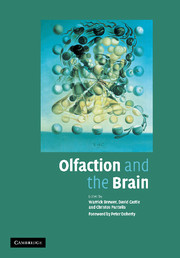Book contents
- Frontmatter
- Contents
- Foreword
- Preface
- List of Contributors
- Section I Neurology, Neurophysiology and Neuropsychology: Olfactory Clues to Brain Development and Disorder
- Section II Social Functioning: Role of Evolution, Genetics and Gender
- 8 Primate Olfaction: Anatomy and Evolution
- 9 Genetics and Family Influences on Olfaction: A Focus in Schizophrenia
- 10 Sex Differences and Olfactory Function
- 11 The Role of Pheromones and Chemistry: Lessons from Comparative Anatomy
- 12 The Impact of Olfaction on Human Social Functioning
- Section III Assessment and Disorders of Olfaction
- Index
- Plate section
- References
8 - Primate Olfaction: Anatomy and Evolution
from Section II - Social Functioning: Role of Evolution, Genetics and Gender
Published online by Cambridge University Press: 17 August 2009
- Frontmatter
- Contents
- Foreword
- Preface
- List of Contributors
- Section I Neurology, Neurophysiology and Neuropsychology: Olfactory Clues to Brain Development and Disorder
- Section II Social Functioning: Role of Evolution, Genetics and Gender
- 8 Primate Olfaction: Anatomy and Evolution
- 9 Genetics and Family Influences on Olfaction: A Focus in Schizophrenia
- 10 Sex Differences and Olfactory Function
- 11 The Role of Pheromones and Chemistry: Lessons from Comparative Anatomy
- 12 The Impact of Olfaction on Human Social Functioning
- Section III Assessment and Disorders of Olfaction
- Index
- Plate section
- References
Summary
Introduction
Primate origins
The living primates are commonly divided into two suborders: Strepsirrhini comprising the lemurs, lorises and galagos; and Haplorhini containing tarsiers and anthropoids (Table 8.1, Figure 8.1). These two groups had diverged from one another by the beginning of the Eocene period (Rose & Bown, 1991), where they are represented by the adapoids and omomyoids respectively. Together, the living and fossil strepsirrhines and haplorhines are known as ‘crown primates’ or ‘euprimates’. Any primates preceding the divergence of the two euprimate suborders would be called stem primates, and a growing body of evidence suggests that the plesiadapiforms, a diverse radiation known mainly from the Paleocene period, are such a group (Bloch & Boyer, 2002). While the origin of stem primates constitutes the true origin of the primate order, most adaptive scenarios of ‘primate origins’ have focused on anatomical differences between euprimates and other mammals.
Of the several theories that have been developed to account for the origin of primates (see Cartmill (1992) and Sussman (1999) for more thorough discussion and original references), two have specific bearing on the topic of this chapter. The arboreal theory (e.g. Jones, 1916; Smith, 1927) holds that the features which distinguish primates from other mammals (divergent hallux and pollex, regressive rostrum, more forward-facing position of the orbits (known as ‘orbital convergence’)) are adaptations for an arboreal existence.
Keywords
- Type
- Chapter
- Information
- Olfaction and the Brain , pp. 135 - 166Publisher: Cambridge University PressPrint publication year: 2006
References
- 37
- Cited by



